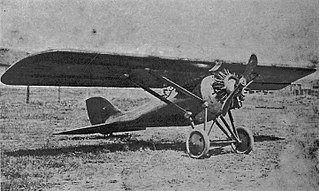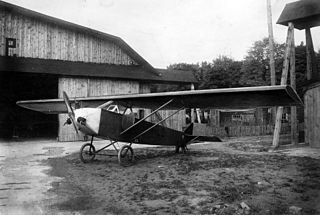
The Farman FF 65 Sport was a French built light biplane, with a single engine and tandem seats, intended for sport and touring. First flown in 1919, it achieved modest sales at home and abroad in the early 1920s. Two unusual modifications produced a biplane glider and a low aspect ratio parasol wing machine.
The Driggs-Johnson DJ-1 Bumblebee was a single engine, low power, single seat, parasol wing sports monoplane built in the US in 1924. It and its immediate development the Driggs Dart 1 had some competition successes; the design was further developed into two seat sesquiplanes known as the Driggs Dart 2 and Skylark. In all, about twenty were built.

The Stahlwerk-Mark R.V, sometimes known as the Stahlwerk-Mark R.V/23 to indicate its year of production, was a small German airliner able to carry three passengers. Two were built.
The Lioré et Olivier LeO 8, Lioré et Olivier LeO 8-Cau 2 or Lioré et Olivier LeO 8 CAN 2 was a French two seat, parasol wing monoplane night fighter and reconnaissance aircraft, built in 1923.
The FVM J 23 was a Swedish single seat, single engine, parasol wing fighter aircraft built in the mid-1920s. Five were flown but the type never reached operational status because of structural concerns raised by a fatal accident.
The Dietrich-Gobiet DP.VII was a simple, low power, German sports aircraft flown in early 1924.

The Müller G.M.G. II was a German single engine, tandem seat sports monoplane from 1928. Its high wing was unusually mounted.

The Potez VIII was a French training aircraft which first flew in 1920. Originally it had a very unusual vertical inline engine and a four-wheeled undercarriage, though the production version was more conventional.

The Caudron Type O was a French single seat air racing biplane first flown in 1914.
The Leduc RL-12 was a French low power, economical, parasol wing, single seat aircraft. First flown in July 1939, its development was halted by World War II.

The Charmier-Dupuy 10 was a French parasol-winged single seat light aircraft designed for low cost flying. The sole example was first flown in 1924. Over a long career, it was fitted with three different engines and remained on the French register until after World War II.
The Peyret-le Prieur seaplane was a low power, two seat biplane floatplane trainer flown in France in 1924. It did not reach production.
The Hanriot H.34 was a basic trainer designed in France in 1924 which did not reach production. It was a parasol wing aircraft, seating two in tandem.

The Magni PM.2 Vittoria was an Italian experimental, single seat, parasol wing aircraft built in the mid-1920s. It had a large area aerofoil on each of its single wing bracing struts which could be rotated together or independently to give lift or drag.

The low-powered Samolot Sp.I, designed in Poland in the mid-1920s, was intended to explore the characteristics of a proposed single seat fighter. The project did not receive government support and only one Sp.1 was built.

The Medwecki HL 2 was a Polish two seat lightplane flown in 1927. Handicapped by a low power, unreliable engine, its flying life lasted little more than a month.
The Medwecki and Nowakowski M.N.3 or just M.N.3 was a low-powered, four seat, Polish aircraft flown in 1928. The sole example was modified into a more powerful two-seater which served aeroclubs until World War II.
The Silesia S-4 was a Polish, low-power parasol wing aircraft built in 1925. After an engine change and airframe modifications it became one of the Silesian Aeroclubs fleet. It was lost in a take-off accident in 1931 and was the last Silesia aircraft to fly.

The Działowski D.K.D.1 was the first powered aircraft designed by Stanislaw Działowski. It was a low-power high-wing monoplane with a cabin for one passenger. After attending an aviation exhibition in Warsaw in 1927 it was badly damaged when the engine failed as it left and it did not fly again.
The Yackey Monoplane was an American three seat parasol monoplane flown in the late 1920s. Two prototypes had some success in the 1927 New York - Spokane National Air Derby and orders were placed but a crash killed its designer and ended production.












